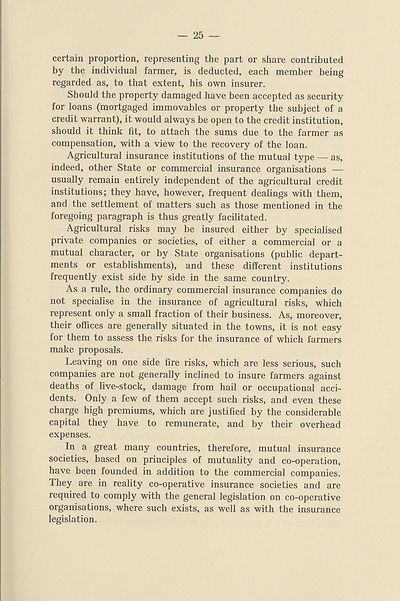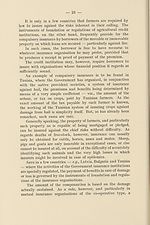Download files
Complete book:
Individual page:
Thumbnail gallery: Grid view | List view

— 25 —
certain proportion, representing the part or share contributed
by the individual farmer, is deducted, each member being
regarded as, to that extent, his own insurer.
Should the property damaged have been accepted as security
for loans (mortgaged immovables or property the subject of a
credit warrant), it would always be open to the credit institution,
should it think fit, to attach the sums due to the farmer as
compensation, with a view to the recovery of the loan.
Agricultural insurance institutions of the mutual type — as,
indeed, other State or commercial insurance organisations —
usually remain entirely independent of the agricultural credit
institutions; they have, however, frequent dealings with them,
and the settlement of matters such as those mentioned in the
foregoing paragraph is thus greatly facilitated.
Agricultural risks may be insured either by specialised
private companies or societies, of either a commercial or a
mutual character, or by State organisations (public depart¬
ments or establishments), and these different institutions
frequently exist side by side in the same country.
As a rule, the ordinary commercial insurance companies do
not specialise in the insurance of agricultural risks, which
represent only a small fraction of their business. As, moreover,
their offices are generally situated in the towns, it is not easy
for them to assess the risks for the insurance of which farmers
make proposals.
Leaving on one side fire risks, which are less serious, such
companies are not generally inclined to insure farmers against
deaths of live-stock, damage from hail or occupational acci¬
dents. Only a few of them accept such risks, and even these
charge high premiums, which are justified by the considerable
capital they have to remunerate, and by their overhead
expenses.
In a great many countries, therefore, mutual insurance
societies, based on principles of mutuality and co-operation,
have been founded in addition to the commercial companies.
They are in reality co-operative insurance societies and are
required to comply with the general legislation on co-operative
organisations, where such exists, as well as with the insurance
legislation.
certain proportion, representing the part or share contributed
by the individual farmer, is deducted, each member being
regarded as, to that extent, his own insurer.
Should the property damaged have been accepted as security
for loans (mortgaged immovables or property the subject of a
credit warrant), it would always be open to the credit institution,
should it think fit, to attach the sums due to the farmer as
compensation, with a view to the recovery of the loan.
Agricultural insurance institutions of the mutual type — as,
indeed, other State or commercial insurance organisations —
usually remain entirely independent of the agricultural credit
institutions; they have, however, frequent dealings with them,
and the settlement of matters such as those mentioned in the
foregoing paragraph is thus greatly facilitated.
Agricultural risks may be insured either by specialised
private companies or societies, of either a commercial or a
mutual character, or by State organisations (public depart¬
ments or establishments), and these different institutions
frequently exist side by side in the same country.
As a rule, the ordinary commercial insurance companies do
not specialise in the insurance of agricultural risks, which
represent only a small fraction of their business. As, moreover,
their offices are generally situated in the towns, it is not easy
for them to assess the risks for the insurance of which farmers
make proposals.
Leaving on one side fire risks, which are less serious, such
companies are not generally inclined to insure farmers against
deaths of live-stock, damage from hail or occupational acci¬
dents. Only a few of them accept such risks, and even these
charge high premiums, which are justified by the considerable
capital they have to remunerate, and by their overhead
expenses.
In a great many countries, therefore, mutual insurance
societies, based on principles of mutuality and co-operation,
have been founded in addition to the commercial companies.
They are in reality co-operative insurance societies and are
required to comply with the general legislation on co-operative
organisations, where such exists, as well as with the insurance
legislation.
Set display mode to:
![]() Universal Viewer |
Universal Viewer | ![]() Mirador |
Large image | Transcription
Mirador |
Large image | Transcription
Images and transcriptions on this page, including medium image downloads, may be used under the Creative Commons Attribution 4.0 International Licence unless otherwise stated. ![]()
| League of Nations > Economic and financial section > Report on systems of Agricultural credit and insurance > (35) |
|---|
| Permanent URL | https://digital.nls.uk/190543689 |
|---|
| Shelfmark | LN.II |
|---|
| Description | Over 1,200 documents from the non-political organs of the League of Nations that dealt with health, disarmament, economic and financial matters for the duration of the League (1919-1945). Also online are statistical bulletins, essential facts, and an overview of the League by the first Secretary General, Sir Eric Drummond. These items are part of the Official Publications collection at the National Library of Scotland. |
|---|---|
| Additional NLS resources: |
|

